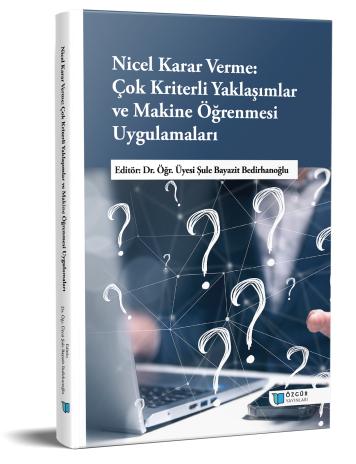
Nicel Karar Verme: Çok Kriterli Yaklaşımlar ve Makine Öğrenmesi Uygulamaları
İndir
Özet
“Bilgi çağının en önemli gereksinimlerinden biri, karmaşık problemlere sistematik ve veriye dayalı çözümler üretebilme yetkinliğidir. Karar verme süreçleri bireylerden topluma ve hatta devletlere kadar her ölçekte stratejik öneme sahiptir. Günümüz dünyasında kararların; doğru olmasının yanı sıra zamanlı, çok boyutlu, dinamik olması gibi özellikleri ile sürekli değişen koşullar altında alınması gerekmektedir. Bu doğrultuda nicel karar verme yaklaşımları özellikle Çok Kriterli Karar Verme (ÇKKV) ve Makine Öğrenmesi yöntemleri karar vericilere güçlü bir yol haritası sunmaktadır. Bu kitap söz konusu iki güçlü metodolojinin teorik temelleri ve güncel uygulamalarını bir araya getirerek alana katkı sunmayı amaçlamaktadır. Farklı disiplinlerden gelen değerli araştırmacıların katkılarıyla şekillenen bur derleme eser, karar verme sürecini anlamak ve iyileştirmek isteyen araştırmacılara disiplinler arası özgün bir perspektif sunmaktadır.
Toplam 8 bölümden oluşan bu kitabın içeriği, okuyucuyu kuramdan uygulamaya doğru uzanan kapsamlı bir yolculuğa çıkarmaktadır. İlk bölüm, ÇKKV yöntemlerinden WENSLO kriter ağırlıklandırma ve CoCoSo sıralama yöntemlerini bir uygulama ile tanıtır. İkinci bölüm, portföy çalışmalarında makine öğrenmesi kullanımını anlamaya yönelik öncü çalışmaların sunulduğu bibliyometrik analizi sunar. Üçüncü bölüm, ENTROPY ve TOPSIS ÇKVV yöntemlerinin birlikte ele alınmasını AB’ne aday ülkeler ile Türkiye’nin sağlık performansını karşılaştırma uygulaması ile gösterir. Dördüncü bölüm, müşteri memnuniyetine yönelik makine öğrenmesi çalışmalarını bibliyometrik bir yaklaşımla analiz eder. Beşinci bölüm, ÇKKV ve makine öğrenmesi entegrasyonunu teorik çerçeve ve uygulama ile açıklar. Altıncı bölüm finansal zaman serisi tahminlemede makine öğrenmesi algoritmalarını inceleyen genel bir çerçeve çizer. Yedinci bölüm FUCOM tabanlı WEDBA güncel ÇKKV yöntemlerinin optimal tedarikçi seçiminde uygulanmasını gösterir. Sekizinci bölüm çeşitli makine öğrenmesi algoritmaları ile çalışanların işten ayrılma olasılığının nasıl tahmin edileceğine yönelik bir uygulama sunar.
Bu kitabın çok kriterli karar verme ve makine öğrenmesi yaklaşımlarıyla nicel karar verme süreçlerini sistematik, veriye dayalı yönetme yetkinliği kazandırmasının yanı sıra, okuyuculara yol gösterici olmasını temenni ediyorum. Kitabın hazırlanmasında katkı sunan tüm yazarlarımıza ve sürece emek veren herkese teşekkür eder; bu çalışmanın okuyuculara ilham vermesini ve gelecekteki araştırmalar için bir başlangıç noktası oluşturmasını dileriz.
Bilimin çok sesli ve disiplinler arası yapısının, daha adil, etkili ve sürdürülebilir kararlar alınmasında yolumuzu aydınlatmaya devam etmesi dileğiyle…
Editör
Dr. Öğr. Üyesi Şule BAYAZİT BEDİRHANOĞLU
Mayıs 2025

